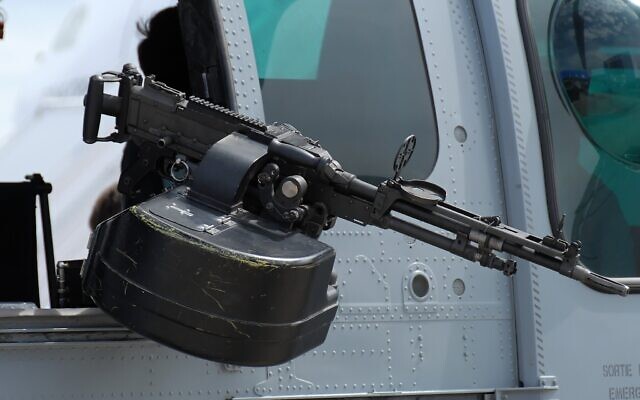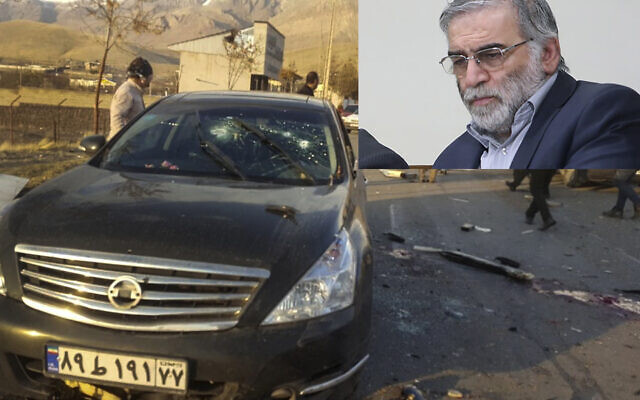- Safe in a command center thousands of miles away, Israeli team reportedly used AI-powered weapon built into abandoned-looking vehicle to take out Mohsen Fakhrizadeh last November
Top Iranian nuclear scientist, Mohsen Fakhrizadeh, was assassinated in November 2020 in a sophisticated hit led by a Mossad team that reportedly deployed a computerized machine gun, required no on-site operatives, took less than a minute, and did not injure anyone else, including the scientist’s wife who was with him at the time.
According to an in-depth New York Times report published on Saturday, the weapon used in the high-profile assassination last year of Fakhrizadeh — regarded by Israel and many Western officials as the “father” of Iran’s nuclear weapons program — was a modified Belgian-made FN MAG machine gun attached to an advanced robotic apparatus and powered with artificial intelligence technology. The whole device weighed about a ton and was smuggled into Iran in small parts ahead of the operation and then reassembled.
The Mossad team handled the whole operation from a command center outside the country, according to the report which the publication said was based on interviews with American, Israeli and Iranian officials, “including two intelligence officials familiar with the details of the planning and execution of the operation.”
The report detailed how Israel had been closely following Fakhrizadeh’s career and movements since at least 2007 and began making preparations for an assassination operation in late 2019 and early 2020, following a series of meetings between Israeli officials led by then-Mossad director Yossi Cohen and high-ranking United States officials, including then-US President Donald Trump, US Secretary of State Mike Pompeo and the CIA director Gina Haspel.
These preparations moved into high gear by the summer of 2020, according to the report, and Israel decided to press ahead, driven by two factors: Iran’s tepid response to the January 2020 killing of its top general Qassim Suleimani in a US drone strike facilitated by Israeli intelligence, and the rising likelihood that Trump would lose the national election that November to Joe Biden, who had indicated he would return the US to the 2015 nuclear agreement with Iran.
“If Israel was going to kill a top Iranian official, an act that had the potential to start a war, it needed the assent and protection of the United States,” the New York Times reported, noting how much Trump and then-premier Benjamin Netanyahu “saw eye to eye.”
“In Mr. Netanyahu’s best-case scenario, the assassination would derail any chance of resurrecting the nuclear agreement even if Mr. Biden won,” the report read.
Fakhrizadeh, 59, a physicist, an officer in the Islamic Revolutionary Guard Corps and a professor at the Imam Hussein University in Tehran, was killed on November 27, 2020, while en route with his wife from their vacation home on the Caspian Sea to their country house in Absard, east of Tehran. He was driving his own vehicle, a black Nissan Teana sedan, with his wife sitting in the passenger seat beside him and his bodyguards in separate cars behind him.
The report detailed how the scientist had disregarded warnings of a possible assassination attempt as well as the advice of his security team, insisting on driving himself in the unarmored car. He no longer took threats to his life seriously having been subjected to them for years. He had previously been targeted for assassination, most recently in 2009 when a hit team was ready to carry out its plan but the operation was called off as the Mossad feared an ambush, the report said.
Meanwhile, that November, the Mossad’s computerized weapon was affixed to an abandoned-looking car, a blue Nissan Zamyad pickup truck, stationed by Iranian agents working with the Israeli agency at a junction on the main road where drivers heading for Absard had to make a U-turn, according to the report. The truck was laden with a camera and explosives so it could be destroyed after the hit.
When the team got word that Fakhrizadeh was heading out, “the assassin, a skilled sniper, took up his position, calibrated the gun sights, cocked the weapon and lightly touched the trigger” — all from an “undisclosed location thousands of miles away” and no longer in Iran. An illustrative photo of a Belgian FN MAG mounted on a Eurocopter EC 725 Cougar MkII at the 2007 Paris Air Show. (Jastrow – Own work, Public Domain, Link)
An illustrative photo of a Belgian FN MAG mounted on a Eurocopter EC 725 Cougar MkII at the 2007 Paris Air Show. (Jastrow – Own work, Public Domain, Link)
The hit team had to overcome several obstacles, including a slight time delay as well as the recoil of the weapon after a shot that could change the trajectory. The report said that “AI [articificial intelligence] was programmed to compensate for the delay, the shake, and the car’s speed,” without going into further detail.
Once Fakhrizadeh’s vehicle arrived at the junction, another vehicle with his bodyguards made way to the vacation home to inspect it before his arrival, leaving him exposed. The remaining vehicles in the convoy slowed for a speed bump just before the parked truck, at which point the operatives could positively identify Fakhrizadeh as the driver of the Nissan. They unleashed a hail of bullets, hitting the car below the windshield.
The report said that it was unknown whether Fakhrizadeh was injured but the car swerved and came to a stop, after which he stepped out and crouched down before the open door. He was then hit with three more bullets that “tore into his spine” and collapsed on the road.
The first bodyguard arrived at the scene with a weapon and “looked around for the assailant, seemingly confused.”
Fakhrizadeh’s wife ran to him and sat beside him on the road. The blue truck then exploded but most of the equipment remained largely intact though severely damaged.
A total of 15 bullets were fired and the whole assassination was over in less than 60 seconds, the New York Times reported. No one else was hit or injured.
The operation was deemed a success, according to the report, given “serious security failures by Iran’s Revolutionary Guards, extensive planning and surveillance by the Mossad, and an insouciance bordering on fatalism on the part of Mr. Fakhrizadeh.”
“The souped-up, remote-controlled machine gun now joins the combat drone in the arsenal of high-tech weapons for remote targeted killing,” and is “likely to reshape the worlds of security and espionage,” the New York Times reported.





